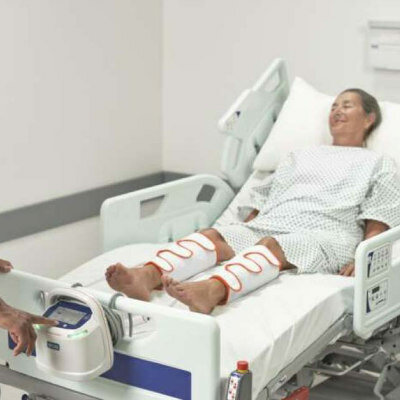Lithoplasty Technology Treats Coronary Artery Disease
|
By HospiMedica International staff writers Posted on 29 May 2017 |

Image: The lithoplasty balloon catheter system (Photo courtesy Shockwave Medical).
A combination of balloon angioplasty and lithotripsy breaks up calcified plaques that cause arteries to narrow and restores blood flow.
The Shockwave Medical lithoplasty system is comprised of balloon dilatation catheter with inset lithotripsy electrodes that increase the compliance of rigid vascular and valvular lesions. The vascular calcium deposits are then subjected to a brief series of powerful mechanical pulses. Stressed from the induced vibrations, the plaque becomes more pliable; the integrated balloon catheter is then dilated at low pressures to expand the lesion evenly, without damaging the vessels themselves.
The pre-treatment enables more effective angioplasty, less frequent bailout stent usage, and enhanced lesion preparation, thus minimizing any potential acute soft tissue injury that could lead to the need for additional interventional treatments or long-term restenosis. The technology is currently undergoing a premarket, prospective, single-arm study in seven sites in Europe and Australia in order to evaluate the use of lithoplasty for treat calcified arteries in CAD patients before they receive a drug-eluting stent.
“Cardiovascular calcification presents a persistent treatment challenge for the interventionalist,” said Jean Fajadet, MD, of Clinique Pasteur (Toulouse, France), co-principal investigator of the international clinical trial of the technology. “The use of lithoplasty in the coronary arteries is an important new option that has shown in the clinical study of the device to effectively prepare the vessel for stent implantation with minimal complications.”
“We are a step closer to bringing lithoplasty to patients and physicians in Europe as a potentially paradigm-changing technology for the treatment of coronary artery disease,” said Doug Godshall, CEO of Shockwave Medical. “We look forward to sharing our final six-month results…and to continuing to gather clinical evidence on the benefits of this promising treatment for a challenging patient population.”
The presence of calcified CAD leads to suboptimal outcomes for all treatment options - medical therapy, interventional treatment, and cardiac surgery. For angioplasty with a stent, the presence of calcified lesions is associated with suboptimal lesion expansion, poor stent apposition, and complications that include dissection, distal embolization, coronary hypoperfusion, and procedural failure.
The Shockwave Medical lithoplasty system is comprised of balloon dilatation catheter with inset lithotripsy electrodes that increase the compliance of rigid vascular and valvular lesions. The vascular calcium deposits are then subjected to a brief series of powerful mechanical pulses. Stressed from the induced vibrations, the plaque becomes more pliable; the integrated balloon catheter is then dilated at low pressures to expand the lesion evenly, without damaging the vessels themselves.
The pre-treatment enables more effective angioplasty, less frequent bailout stent usage, and enhanced lesion preparation, thus minimizing any potential acute soft tissue injury that could lead to the need for additional interventional treatments or long-term restenosis. The technology is currently undergoing a premarket, prospective, single-arm study in seven sites in Europe and Australia in order to evaluate the use of lithoplasty for treat calcified arteries in CAD patients before they receive a drug-eluting stent.
“Cardiovascular calcification presents a persistent treatment challenge for the interventionalist,” said Jean Fajadet, MD, of Clinique Pasteur (Toulouse, France), co-principal investigator of the international clinical trial of the technology. “The use of lithoplasty in the coronary arteries is an important new option that has shown in the clinical study of the device to effectively prepare the vessel for stent implantation with minimal complications.”
“We are a step closer to bringing lithoplasty to patients and physicians in Europe as a potentially paradigm-changing technology for the treatment of coronary artery disease,” said Doug Godshall, CEO of Shockwave Medical. “We look forward to sharing our final six-month results…and to continuing to gather clinical evidence on the benefits of this promising treatment for a challenging patient population.”
The presence of calcified CAD leads to suboptimal outcomes for all treatment options - medical therapy, interventional treatment, and cardiac surgery. For angioplasty with a stent, the presence of calcified lesions is associated with suboptimal lesion expansion, poor stent apposition, and complications that include dissection, distal embolization, coronary hypoperfusion, and procedural failure.
Latest Surgical Techniques News
- Robotic Assistant Delivers Ultra-Precision Injections with Rapid Setup Times
- Minimally Invasive Endoscopic Surgery Improves Severe Stroke Outcomes
- Novel Glue Prevents Complications After Breast Cancer Surgery
- Breakthrough Brain Implant Enables Safer and More Precise Drug Delivery
- Bioadhesive Sponge Stops Uncontrolled Internal Bleeding During Surgery
- Revolutionary Nano Bone Material to Accelerate Surgery and Healing
- Superior Orthopedic Implants Combat Infections and Quicken Healing After Surgery
- Laser-Based Technique Eliminates Pancreatic Tumors While Protecting Healthy Tissue
- Surgical Treatment of Severe Carotid Artery Stenosis Benefits Blood-Brain Barrier
- Revolutionary Reusable Duodenoscope Introduces 68-Minute Sterilization
- World's First Transcatheter Smart Implant Monitors and Treats Congestion in Heart Failure
- Hybrid Endoscope Marks Breakthrough in Surgical Visualization
- Robot-Assisted Bronchoscope Diagnoses Tiniest and Hardest to Reach Lung Tumors
- Diamond-Titanium Device Paves Way for Smart Implants that Warn of Disease Progression
- 3D Printable Bio-Active Glass Could Serve as Bone Replacement Material
- Spider-Inspired Magnetic Soft Robots to Perform Minimally Invasive GI Tract Procedures
Channels
Critical Care
view channel
CPR Guidelines Updated for Pediatric and Neonatal Emergency Care and Resuscitation
Cardiac arrest in infants and children remains a leading cause of pediatric emergencies, with more than 7,000 out-of-hospital and 20,000 in-hospital cardiac arrests occurring annually in the United States.... Read more
Ingestible Capsule Monitors Intestinal Inflammation
Acute mesenteric ischemia—a life-threatening condition caused by blocked blood flow to the intestines—remains difficult to diagnose early because its symptoms often mimic common digestive problems.... Read more
Wireless Implantable Sensor Enables Continuous Endoleak Monitoring
Endovascular aneurysm repair (EVAR) is a life-saving, minimally invasive treatment for abdominal aortic aneurysms—balloon-like bulges in the aorta that can rupture with fatal consequences.... Read more
Wearable Patch for Early Skin Cancer Detection to Reduce Unnecessary Biopsies
Skin cancer remains one of the most dangerous and common cancers worldwide, with early detection crucial for improving survival rates. Traditional diagnostic methods—visual inspections, imaging, and biopsies—can... Read morePatient Care
view channel
Revolutionary Automatic IV-Line Flushing Device to Enhance Infusion Care
More than 80% of in-hospital patients receive intravenous (IV) therapy. Every dose of IV medicine delivered in a small volume (<250 mL) infusion bag should be followed by subsequent flushing to ensure... Read more
VR Training Tool Combats Contamination of Portable Medical Equipment
Healthcare-associated infections (HAIs) impact one in every 31 patients, cause nearly 100,000 deaths each year, and cost USD 28.4 billion in direct medical expenses. Notably, up to 75% of these infections... Read more
Portable Biosensor Platform to Reduce Hospital-Acquired Infections
Approximately 4 million patients in the European Union acquire healthcare-associated infections (HAIs) or nosocomial infections each year, with around 37,000 deaths directly resulting from these infections,... Read moreFirst-Of-Its-Kind Portable Germicidal Light Technology Disinfects High-Touch Clinical Surfaces in Seconds
Reducing healthcare-acquired infections (HAIs) remains a pressing issue within global healthcare systems. In the United States alone, 1.7 million patients contract HAIs annually, leading to approximately... Read moreHealth IT
view channel
Printable Molecule-Selective Nanoparticles Enable Mass Production of Wearable Biosensors
The future of medicine is likely to focus on the personalization of healthcare—understanding exactly what an individual requires and delivering the appropriate combination of nutrients, metabolites, and... Read moreBusiness
view channel
Philips and Masimo Partner to Advance Patient Monitoring Measurement Technologies
Royal Philips (Amsterdam, Netherlands) and Masimo (Irvine, California, USA) have renewed their multi-year strategic collaboration, combining Philips’ expertise in patient monitoring with Masimo’s noninvasive... Read more
B. Braun Acquires Digital Microsurgery Company True Digital Surgery
The high-end microsurgery market in neurosurgery, spine, and ENT is undergoing a significant transformation. Traditional analog microscopes are giving way to digital exoscopes, which provide improved visualization,... Read more
CMEF 2025 to Promote Holistic and High-Quality Development of Medical and Health Industry
The 92nd China International Medical Equipment Fair (CMEF 2025) Autumn Exhibition is scheduled to be held from September 26 to 29 at the China Import and Export Fair Complex (Canton Fair Complex) in Guangzhou.... Read more












